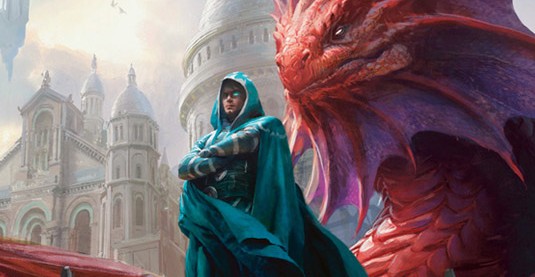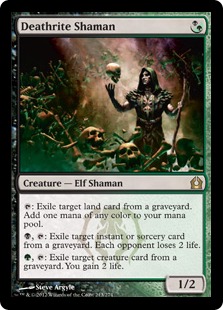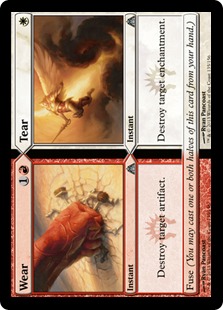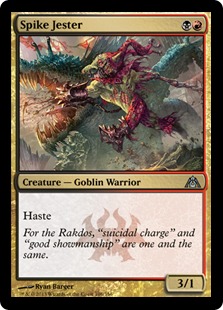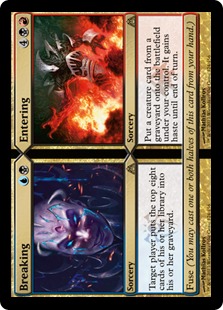In just a few months time Return To Ravnica, Gatecrash, and Dragon’s Maze will finish their tour of standard and retire to their long-term home in magic’s eternal formats. As standard players start thinking about either offloading their rotating cards or testing out the waters of modern, its worth reflecting on what cards from this block had an impact on the format (besides the obvious shockland reprints). From my experience, these are the cards from RTR block that had noticeable impacts on the format, from highest to lowest:
The highest impact card by far. It turns out that a one mana 1/2 that accelerates, provides graveyard hate, and late game reach is oppressively good, and the shaman enjoyed only a brief stay before being banned. Somewhat ironically, the card went virtually unplayed in standard
Abrupt Decay finds itself in some pretty exclusive company, joining the likes of Path to Exile, Lightning Bolt and Dismember as a staple removal spell. Abrupt Decay answers most of the commonly played creatures in modern, while also extending its reach to things like Cranial Plating, Blood Moon, and Liliana of the Veil. Being an uncounterable answer to Pestermite or Deceiver Exarch doesn’t hurt either.
While some decks still prefer Relic of Progenitus, Rest In Peace is the gold standard of graveyard hate in modern. Just two mana to clear out all existing and future graveyards, countering effects of cards like Wurmcoil Engine and Voice of Resurgence while also depriving cards like Tarmogoyf and Snapcaster Mage of any value. Not quite good enough to maindeck, but a very common and effective sideboard card.
While voice looks like it should primarily be a way to deal with counter-magic, its modern usage is almost exclusively for the graveyard trigger. It is mainly played in Birthing Pod decks, where the 2/2 gets routinely upgraded into a Kitchen Finks and leaves behind a 4/4 or larger elemental that can itself be turned into a Viscera Seer, should Melira-based combos be on the agenda.
A key piece of the modern storm deck, Electromancer provided a third “engine” to fuel those 20 point Grapeshots. A turn 2 Electromancer is also the most common prequel to a turn 3 kill for storm decks - Seething Song or not!
Sphinx’s Revelation deserves the most credit for making UWx control decks work in modern, but each of these played a role. It’s amazing how much better Blue Sun’s Zenith gets when you add on some life gain and let it hit the graveyard for Snapcaster Mage. By comparison supreme verdict and detention sphere are relatively minor upgrades over wrath of god and oblivion ring.
Rakdos Charm is like the ultimate sideboard card for modern, efficiently providing hate against three of the best decks in the format (pod, twin, affinity) while also effectively answering fringe graveyard decks like Living End, Gifts Ungiven, and Goryo's Vengeance. Whether you’re shattering a Cranial Plating or Birthing Pod, countering a Snapcaster Mage or Kitchen Finks trigger, shrinking a Tarmogoyf, or turning a Splinter Twin infinite win into an infinite loss, Rakdos Charm rarely disappoints.
Not being a bogles player myself I can’t say for certain how much of a boon these cards were to the deck, but having played against it I can say that Ethereal Armor gets out of control very quickly. While Unflinching Courage is also brutal to play against, the deck doesn’t always make its third land drop and the effect overlaps with Daybreak Coronet and Rancor, so I would imagine unflinching courage had less of an impact on the deck’s popularity or success.
Sin Collector shows up as a one-of in Birthing Pod decks and occasionally in the sideboard of black/white token decks. While Tidehollow Sculler and Entomber Exarch have similar effects, permanently exiling a spell frequently matters against cards like Snapcaster Mage and Lingering Souls.
These cards represent small upgrades over the timeshifted Disenchant for decks that can support them. I personally dislike Sundering Growth in my tokens deck, as Blood Moon is a card I want to hit with this and double white makes that harder to do but there are people who swear by that extra spirit token. On the other hand wear/tear is a card I run over disenchant every time I can. The first time you shred a blood moon and a Cranial Plating or a Courser of Kruphix and a Batterskull you’ll never look back.
Not quite a reprint of the rack, but close enough that it got paired with its timeshifted predecessor in a tier 2 deck dubbed “eight rack”. The (usually) mono-black deck is full of discard spells and ends the game by sitting behind an ensnaring bridge and discard spells while its “eight racks” go after the opponent’s life total.
For all of the casual players that wanted to cast Tainted Strike or Assault Strobe on their Kiln Fiends in modern, Nivmagus Elemental delivers what wee dragonauts could not. A one drop that quickly and easily dodges lightning bolts (thank you Gut Shot and Mutagenic Growth) Nivmagus either gets there itself on turn 2 or 3 by chewing up stormed copies of Ground Rift, or soaks up enough of the opponent’s hate cards that a Kiln Fiend can break through in the aftermath.
Unlike Rakdos Charm which is played for its versatility, Boros Charm is played almost exclusively for its 4 damage in burn decks. Skullcrack has also seen play in modern burn, where it helps keep the opponent from stabilizing off of cards like Kitchen Finks, Wurmcoil Engine or Sphinx’s Revelation.
Izzet Charm is a fairly rare sight in modern, but occasionally shows up in both control and combo decks. The blue-red charm is a versatile 2 mana removal spell that digs for answers or combo pieces when removal isn’t needed, and is particularly good at setting up graveyard-based combos.
These two mass bounce spells see play in blue tron decks. While similar effects can be found on cards like inundate and evacuation, the single blue mana requirement is crucial for blue tron, as its focused on assembling three colourless lands as quickly as possible. Aetherize is particularly effective, as a turn two Talisman of Dominance enables a turn 3 Aetherize, which is early enough to hold off fast decks like zoo or infect until Wurmcoil Engine or Platinum Angel resolve.
Despite the unbanning of Wild Nacatl, zoo decks have not been particularly good lately (I blame Anger of the Gods). However when zoo is on the table, these three cards are often in play. Experiment One is particularly good when paired with cards like Kird Ape, Wild Nacatl, and Tarmogoyf, and curving a Burning-Tree Emissary into a mix of any of the above is excellent pressure on turn 2. The rampager is often just valuable for being a beefier colossal might that can’t be stopped by Remand or Spellskite, but its not unheard of for him to go beast mode and trample in for damage himself.
A straight upgrade over Cranial Extraction and Memoricide for decks that can pay the red (be honest - what are you splicing onto arcane?). Slaughter Games does not see a tonne of play as most modern combo decks play multiple win conditions and/or combo off before turn 4. Slaughter Games can still sneak in wins occasionally when it hits a Grapeshot, Scapeshift, or Ad Nauseam if the opponent hasn’t sideboarded in alternate win conditions like Empty the Warrens, Obstinate Baloth, or Hive Mind respectively.
A relevant turn one play against snapcaster mage and Lingering Souls, militant has only really seen play in hate bear decks, which themselves are not played that much. Most modern decks are looking for either a higher impact threat or higher impact hate card, rather than compromising on a card that’s mediocre at both.
Although its too slow for most modern decks, reckoner has found a home in “skred red” (monored control), where it acts as both an answer to early Tarmogoyfs and a potential combo kill via Earthquake, Blasphemous Act, or Skred.
Goblins is a tier 2 deck that occasionally performs well at major events but like zoo is suppressed by anger of the gods. While Foundry-Street Denizen isn’t quite Goblin Guide, it is a surprisingly potent one-drop that almost always swings for 2 and occasionally 3 or 4. Rakdos builds will also use Spike Jester to create frequent turn 3 goldfish kills (e.g. Goblin Guide, jester, jester + Goblin Grenade).
To the extent people keep trying to make an effective modern mill deck, Crypt Incursion represents a reasonable maindeck and an excellent sideboard card. Milling 20-30 cards in the first three turns and then landing a crypt incursion for 15+ life will often buy that one extra turn needed to out-race the damage with mill. Breaking represents a very small upgrade over Mind Sculpt, as I’m not sure any mill deck wants to get to 6 mana to cast entering.
While I’ve only seen this card played a few times, I wanted to include it here because it seems like it should be solid in the format. Unfortunately it seems like protection from Remand, Mana Leak, Lightning Bolt, and liliana’s +1 just don’t stack up to 3 mana’s worth of value in the current metagame. I’m still holding onto my playset as the time should eventually come where this is the right call over competing three-drops like kitchen finks, blade splicer, or knight of the reliquary.
Like the smiter, this one is more of a speculative call. I’ve seen Pack Rat in a few black/white lists (apparently the archetype is being called “deadguy ale”), and I think it has potential going forward. Turn 1 Thoughtseize can tell you whether its worth trying the turn 2 pack rat barrage, or if you should play the attrition game and use a turn 5 pack rat to convert every topdeck into value. Add a high land count, Dark Confidant, Lingering Souls, and stir!

